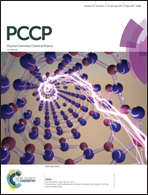Double electron–electron resonance with multiple non-selective chirp refocusing†
Abstract
A new approach to double electron–electron resonance (DEER) for distance determination involving nitroxide spin labels at dilute concentrations is presented. In general, DEER pulse sequences rely on double resonance between pump and observer spins excited by selective pulses at two distinct microwave frequencies. In the new approach abbreviated as nDEER, non-selective chirp pulses that refocus all relevant spin pairs are combined with DEER. This non-selective refocusing results in suppression of unmodulated contributions, such as the constant contribution as well as the background curvature due to inter-molecular spin partners in ordinary DEER data. Due to this dipolar attenuation effect, primary nDEER data are closer to the dipolar modulation of primary interest than ordinary DEER data. Restrictions of nDEER are that secondary information related to these unmodulated contributions becomes difficult to retrieve. Accordingly, incomplete deconvolution of the inter-molecular background prevents the application of nDEER to rigid spin pairs at high concentrations. A key advantage of nDEER is the high fidelity of the chirp refocusing pulses, which is important for nDEER schemes that incorporate dynamical decoupling to access longer distances. In this context, nDEER with Carr-Purcell (CP) pulse trains having N = 2 and N = 4 refocusing pulses are demonstrated. These CP nDEER sequences require a total of N + 2 pulses, which is less than the 2N + 1 pulses required for CP DEER schemes. The pump pulse position is incremented throughout the refocusing pulses, which restricts the minimum time increment to 96 ns on our spectrometer and therefore complicates application to distances below 3 nm. At Q-band frequencies, unwanted modulations related to pulse imperfections contribute only 3.5% relative to the principal nDEER modulation. Accordingly, there is no need for dedicated data reconstruction methods as in CP DEER methods.

- This article is part of the themed collection: 2017 PCCP HOT Articles


 Please wait while we load your content...
Please wait while we load your content...